Perioperative Nursing Practice and Research Review
VerifiedAdded on 2020/10/22
|11
|3681
|225
AI Summary
The assignment provides a comprehensive review of several studies and research papers related to perioperative nursing practices. The reports cover topics such as patient safety, teamwork, sedation protocols, and nursing education. The sources include academic journals like ACORN, BJAN, and Endoscopy International Open, as well as conference proceedings and online resources. The report aims to provide an overview of the current state of perioperative nursing research and practices, highlighting key findings and recommendations for future studies.
Contribute Materials
Your contribution can guide someone’s learning journey. Share your
documents today.

ASSESSMENT TASK 1 CASE STUDY,
ANZCA AND ACORN GUIDELINE,
STANDARDS
ANZCA AND ACORN GUIDELINE,
STANDARDS
Secure Best Marks with AI Grader
Need help grading? Try our AI Grader for instant feedback on your assignments.
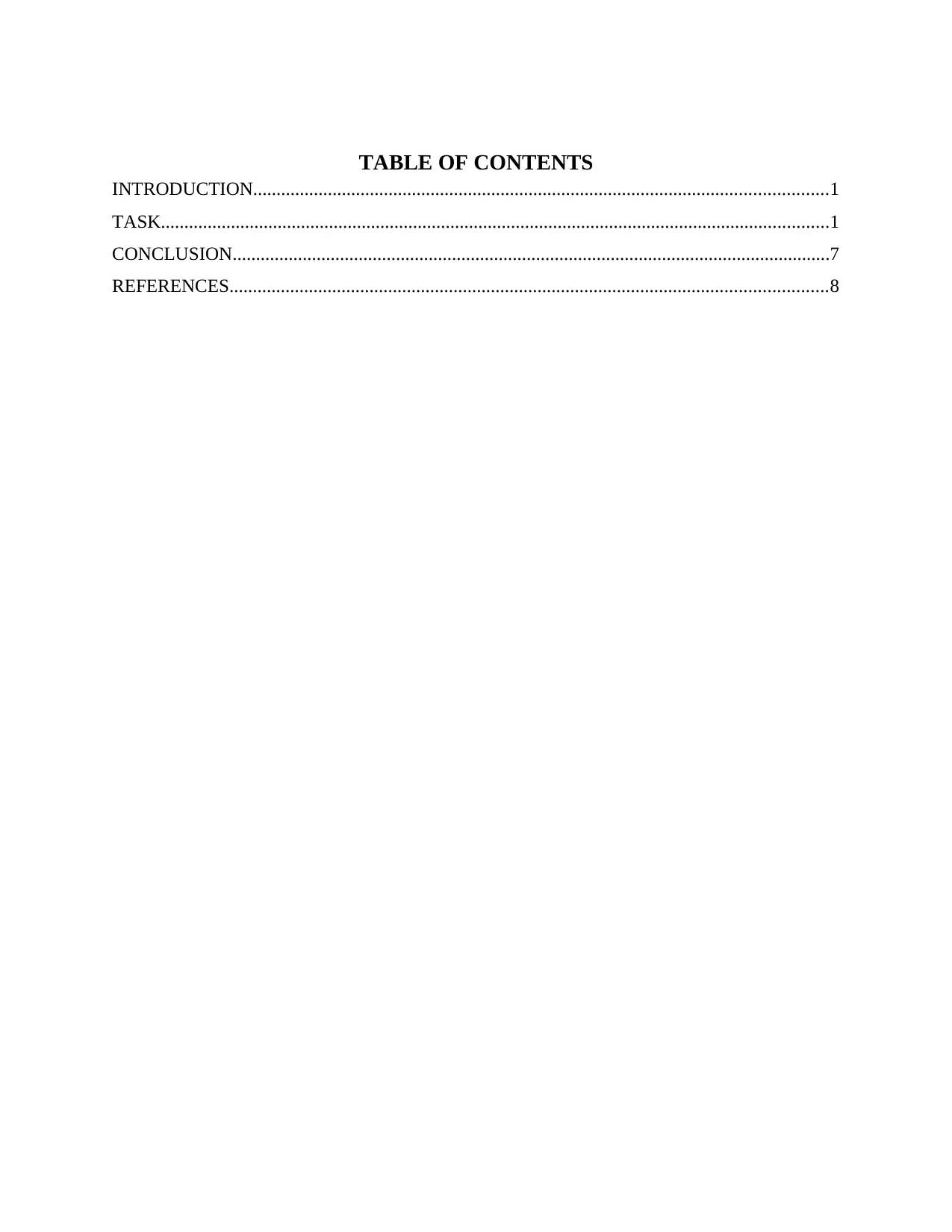
TABLE OF CONTENTS
INTRODUCTION...........................................................................................................................1
TASK...............................................................................................................................................1
CONCLUSION................................................................................................................................7
REFERENCES................................................................................................................................8
INTRODUCTION...........................................................................................................................1
TASK...............................................................................................................................................1
CONCLUSION................................................................................................................................7
REFERENCES................................................................................................................................8
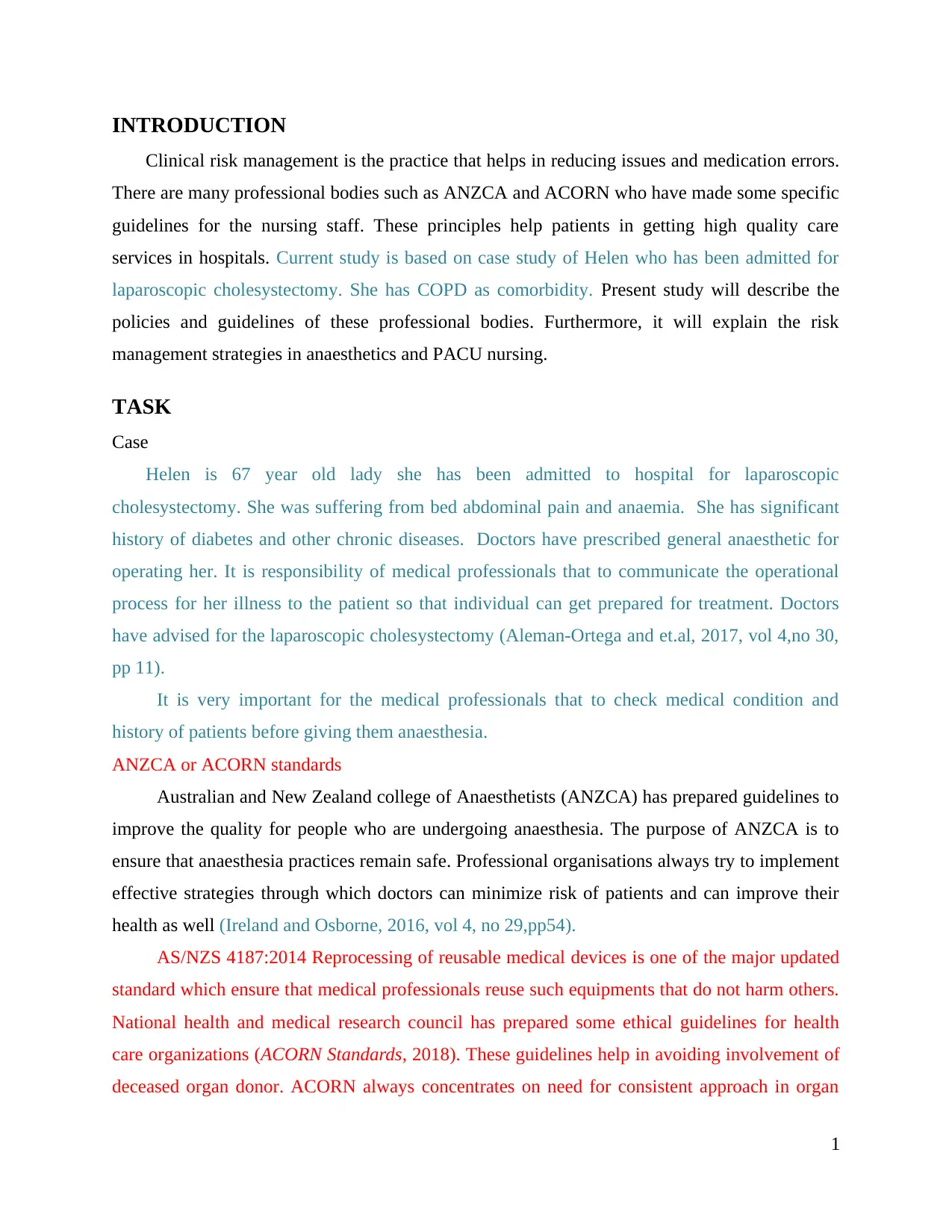
INTRODUCTION
Clinical risk management is the practice that helps in reducing issues and medication errors.
There are many professional bodies such as ANZCA and ACORN who have made some specific
guidelines for the nursing staff. These principles help patients in getting high quality care
services in hospitals. Current study is based on case study of Helen who has been admitted for
laparoscopic cholesystectomy. She has COPD as comorbidity. Present study will describe the
policies and guidelines of these professional bodies. Furthermore, it will explain the risk
management strategies in anaesthetics and PACU nursing.
TASK
Case
Helen is 67 year old lady she has been admitted to hospital for laparoscopic
cholesystectomy. She was suffering from bed abdominal pain and anaemia. She has significant
history of diabetes and other chronic diseases. Doctors have prescribed general anaesthetic for
operating her. It is responsibility of medical professionals that to communicate the operational
process for her illness to the patient so that individual can get prepared for treatment. Doctors
have advised for the laparoscopic cholesystectomy (Aleman-Ortega and et.al, 2017, vol 4,no 30,
pp 11).
It is very important for the medical professionals that to check medical condition and
history of patients before giving them anaesthesia.
ANZCA or ACORN standards
Australian and New Zealand college of Anaesthetists (ANZCA) has prepared guidelines to
improve the quality for people who are undergoing anaesthesia. The purpose of ANZCA is to
ensure that anaesthesia practices remain safe. Professional organisations always try to implement
effective strategies through which doctors can minimize risk of patients and can improve their
health as well (Ireland and Osborne, 2016, vol 4, no 29,pp54).
AS/NZS 4187:2014 Reprocessing of reusable medical devices is one of the major updated
standard which ensure that medical professionals reuse such equipments that do not harm others.
National health and medical research council has prepared some ethical guidelines for health
care organizations (ACORN Standards, 2018). These guidelines help in avoiding involvement of
deceased organ donor. ACORN always concentrates on need for consistent approach in organ
1
Clinical risk management is the practice that helps in reducing issues and medication errors.
There are many professional bodies such as ANZCA and ACORN who have made some specific
guidelines for the nursing staff. These principles help patients in getting high quality care
services in hospitals. Current study is based on case study of Helen who has been admitted for
laparoscopic cholesystectomy. She has COPD as comorbidity. Present study will describe the
policies and guidelines of these professional bodies. Furthermore, it will explain the risk
management strategies in anaesthetics and PACU nursing.
TASK
Case
Helen is 67 year old lady she has been admitted to hospital for laparoscopic
cholesystectomy. She was suffering from bed abdominal pain and anaemia. She has significant
history of diabetes and other chronic diseases. Doctors have prescribed general anaesthetic for
operating her. It is responsibility of medical professionals that to communicate the operational
process for her illness to the patient so that individual can get prepared for treatment. Doctors
have advised for the laparoscopic cholesystectomy (Aleman-Ortega and et.al, 2017, vol 4,no 30,
pp 11).
It is very important for the medical professionals that to check medical condition and
history of patients before giving them anaesthesia.
ANZCA or ACORN standards
Australian and New Zealand college of Anaesthetists (ANZCA) has prepared guidelines to
improve the quality for people who are undergoing anaesthesia. The purpose of ANZCA is to
ensure that anaesthesia practices remain safe. Professional organisations always try to implement
effective strategies through which doctors can minimize risk of patients and can improve their
health as well (Ireland and Osborne, 2016, vol 4, no 29,pp54).
AS/NZS 4187:2014 Reprocessing of reusable medical devices is one of the major updated
standard which ensure that medical professionals reuse such equipments that do not harm others.
National health and medical research council has prepared some ethical guidelines for health
care organizations (ACORN Standards, 2018). These guidelines help in avoiding involvement of
deceased organ donor. ACORN always concentrates on need for consistent approach in organ
1
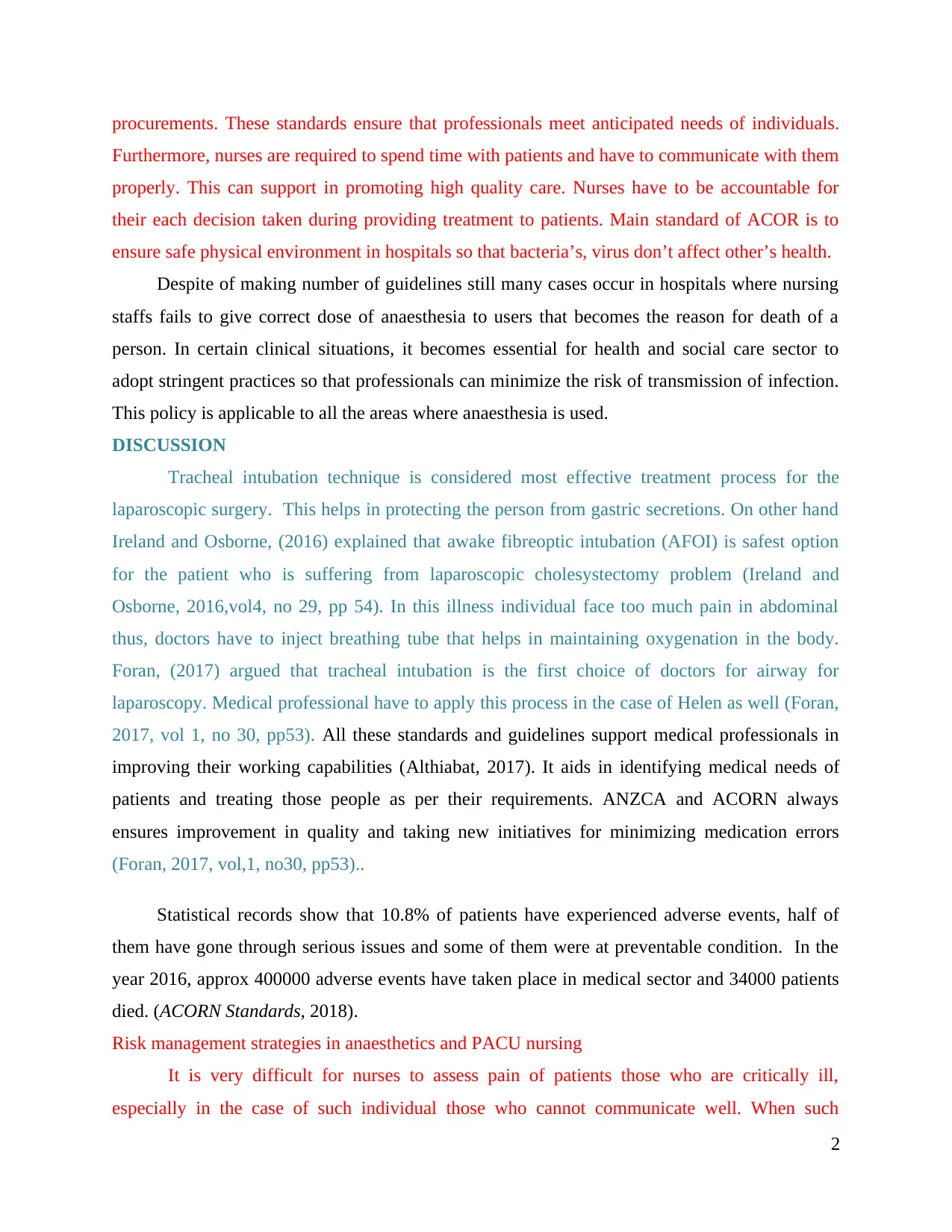
procurements. These standards ensure that professionals meet anticipated needs of individuals.
Furthermore, nurses are required to spend time with patients and have to communicate with them
properly. This can support in promoting high quality care. Nurses have to be accountable for
their each decision taken during providing treatment to patients. Main standard of ACOR is to
ensure safe physical environment in hospitals so that bacteria’s, virus don’t affect other’s health.
Despite of making number of guidelines still many cases occur in hospitals where nursing
staffs fails to give correct dose of anaesthesia to users that becomes the reason for death of a
person. In certain clinical situations, it becomes essential for health and social care sector to
adopt stringent practices so that professionals can minimize the risk of transmission of infection.
This policy is applicable to all the areas where anaesthesia is used.
DISCUSSION
Tracheal intubation technique is considered most effective treatment process for the
laparoscopic surgery. This helps in protecting the person from gastric secretions. On other hand
Ireland and Osborne, (2016) explained that awake fibreoptic intubation (AFOI) is safest option
for the patient who is suffering from laparoscopic cholesystectomy problem (Ireland and
Osborne, 2016,vol4, no 29, pp 54). In this illness individual face too much pain in abdominal
thus, doctors have to inject breathing tube that helps in maintaining oxygenation in the body.
Foran, (2017) argued that tracheal intubation is the first choice of doctors for airway for
laparoscopy. Medical professional have to apply this process in the case of Helen as well (Foran,
2017, vol 1, no 30, pp53). All these standards and guidelines support medical professionals in
improving their working capabilities (Althiabat, 2017). It aids in identifying medical needs of
patients and treating those people as per their requirements. ANZCA and ACORN always
ensures improvement in quality and taking new initiatives for minimizing medication errors
(Foran, 2017, vol,1, no30, pp53)..
Statistical records show that 10.8% of patients have experienced adverse events, half of
them have gone through serious issues and some of them were at preventable condition. In the
year 2016, approx 400000 adverse events have taken place in medical sector and 34000 patients
died. (ACORN Standards, 2018).
Risk management strategies in anaesthetics and PACU nursing
It is very difficult for nurses to assess pain of patients those who are critically ill,
especially in the case of such individual those who cannot communicate well. When such
2
Furthermore, nurses are required to spend time with patients and have to communicate with them
properly. This can support in promoting high quality care. Nurses have to be accountable for
their each decision taken during providing treatment to patients. Main standard of ACOR is to
ensure safe physical environment in hospitals so that bacteria’s, virus don’t affect other’s health.
Despite of making number of guidelines still many cases occur in hospitals where nursing
staffs fails to give correct dose of anaesthesia to users that becomes the reason for death of a
person. In certain clinical situations, it becomes essential for health and social care sector to
adopt stringent practices so that professionals can minimize the risk of transmission of infection.
This policy is applicable to all the areas where anaesthesia is used.
DISCUSSION
Tracheal intubation technique is considered most effective treatment process for the
laparoscopic surgery. This helps in protecting the person from gastric secretions. On other hand
Ireland and Osborne, (2016) explained that awake fibreoptic intubation (AFOI) is safest option
for the patient who is suffering from laparoscopic cholesystectomy problem (Ireland and
Osborne, 2016,vol4, no 29, pp 54). In this illness individual face too much pain in abdominal
thus, doctors have to inject breathing tube that helps in maintaining oxygenation in the body.
Foran, (2017) argued that tracheal intubation is the first choice of doctors for airway for
laparoscopy. Medical professional have to apply this process in the case of Helen as well (Foran,
2017, vol 1, no 30, pp53). All these standards and guidelines support medical professionals in
improving their working capabilities (Althiabat, 2017). It aids in identifying medical needs of
patients and treating those people as per their requirements. ANZCA and ACORN always
ensures improvement in quality and taking new initiatives for minimizing medication errors
(Foran, 2017, vol,1, no30, pp53)..
Statistical records show that 10.8% of patients have experienced adverse events, half of
them have gone through serious issues and some of them were at preventable condition. In the
year 2016, approx 400000 adverse events have taken place in medical sector and 34000 patients
died. (ACORN Standards, 2018).
Risk management strategies in anaesthetics and PACU nursing
It is very difficult for nurses to assess pain of patients those who are critically ill,
especially in the case of such individual those who cannot communicate well. When such
2
Secure Best Marks with AI Grader
Need help grading? Try our AI Grader for instant feedback on your assignments.
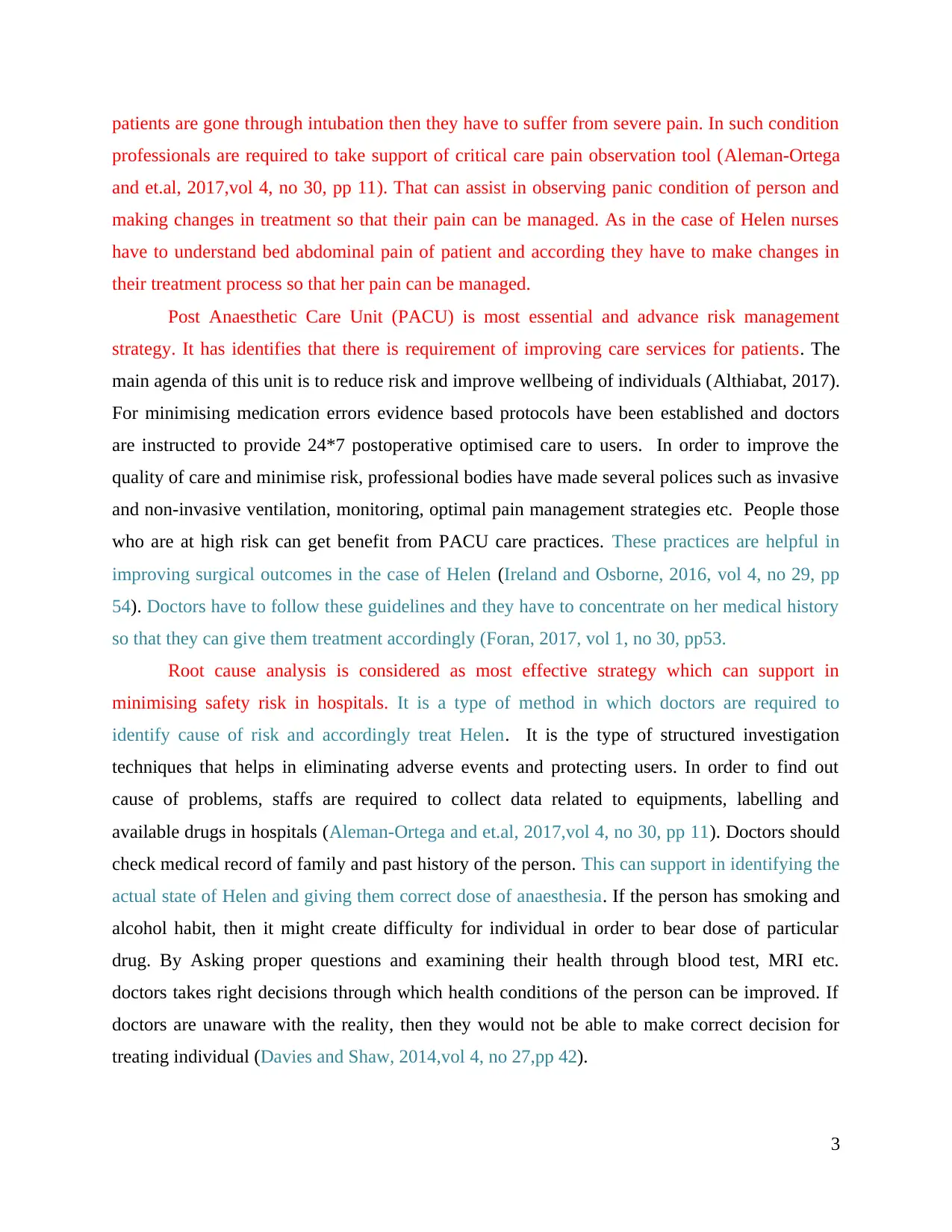
patients are gone through intubation then they have to suffer from severe pain. In such condition
professionals are required to take support of critical care pain observation tool (Aleman-Ortega
and et.al, 2017,vol 4, no 30, pp 11). That can assist in observing panic condition of person and
making changes in treatment so that their pain can be managed. As in the case of Helen nurses
have to understand bed abdominal pain of patient and according they have to make changes in
their treatment process so that her pain can be managed.
Post Anaesthetic Care Unit (PACU) is most essential and advance risk management
strategy. It has identifies that there is requirement of improving care services for patients. The
main agenda of this unit is to reduce risk and improve wellbeing of individuals (Althiabat, 2017).
For minimising medication errors evidence based protocols have been established and doctors
are instructed to provide 24*7 postoperative optimised care to users. In order to improve the
quality of care and minimise risk, professional bodies have made several polices such as invasive
and non-invasive ventilation, monitoring, optimal pain management strategies etc. People those
who are at high risk can get benefit from PACU care practices. These practices are helpful in
improving surgical outcomes in the case of Helen (Ireland and Osborne, 2016, vol 4, no 29, pp
54). Doctors have to follow these guidelines and they have to concentrate on her medical history
so that they can give them treatment accordingly (Foran, 2017, vol 1, no 30, pp53.
Root cause analysis is considered as most effective strategy which can support in
minimising safety risk in hospitals. It is a type of method in which doctors are required to
identify cause of risk and accordingly treat Helen. It is the type of structured investigation
techniques that helps in eliminating adverse events and protecting users. In order to find out
cause of problems, staffs are required to collect data related to equipments, labelling and
available drugs in hospitals (Aleman-Ortega and et.al, 2017,vol 4, no 30, pp 11). Doctors should
check medical record of family and past history of the person. This can support in identifying the
actual state of Helen and giving them correct dose of anaesthesia. If the person has smoking and
alcohol habit, then it might create difficulty for individual in order to bear dose of particular
drug. By Asking proper questions and examining their health through blood test, MRI etc.
doctors takes right decisions through which health conditions of the person can be improved. If
doctors are unaware with the reality, then they would not be able to make correct decision for
treating individual (Davies and Shaw, 2014,vol 4, no 27,pp 42).
3
professionals are required to take support of critical care pain observation tool (Aleman-Ortega
and et.al, 2017,vol 4, no 30, pp 11). That can assist in observing panic condition of person and
making changes in treatment so that their pain can be managed. As in the case of Helen nurses
have to understand bed abdominal pain of patient and according they have to make changes in
their treatment process so that her pain can be managed.
Post Anaesthetic Care Unit (PACU) is most essential and advance risk management
strategy. It has identifies that there is requirement of improving care services for patients. The
main agenda of this unit is to reduce risk and improve wellbeing of individuals (Althiabat, 2017).
For minimising medication errors evidence based protocols have been established and doctors
are instructed to provide 24*7 postoperative optimised care to users. In order to improve the
quality of care and minimise risk, professional bodies have made several polices such as invasive
and non-invasive ventilation, monitoring, optimal pain management strategies etc. People those
who are at high risk can get benefit from PACU care practices. These practices are helpful in
improving surgical outcomes in the case of Helen (Ireland and Osborne, 2016, vol 4, no 29, pp
54). Doctors have to follow these guidelines and they have to concentrate on her medical history
so that they can give them treatment accordingly (Foran, 2017, vol 1, no 30, pp53.
Root cause analysis is considered as most effective strategy which can support in
minimising safety risk in hospitals. It is a type of method in which doctors are required to
identify cause of risk and accordingly treat Helen. It is the type of structured investigation
techniques that helps in eliminating adverse events and protecting users. In order to find out
cause of problems, staffs are required to collect data related to equipments, labelling and
available drugs in hospitals (Aleman-Ortega and et.al, 2017,vol 4, no 30, pp 11). Doctors should
check medical record of family and past history of the person. This can support in identifying the
actual state of Helen and giving them correct dose of anaesthesia. If the person has smoking and
alcohol habit, then it might create difficulty for individual in order to bear dose of particular
drug. By Asking proper questions and examining their health through blood test, MRI etc.
doctors takes right decisions through which health conditions of the person can be improved. If
doctors are unaware with the reality, then they would not be able to make correct decision for
treating individual (Davies and Shaw, 2014,vol 4, no 27,pp 42).
3
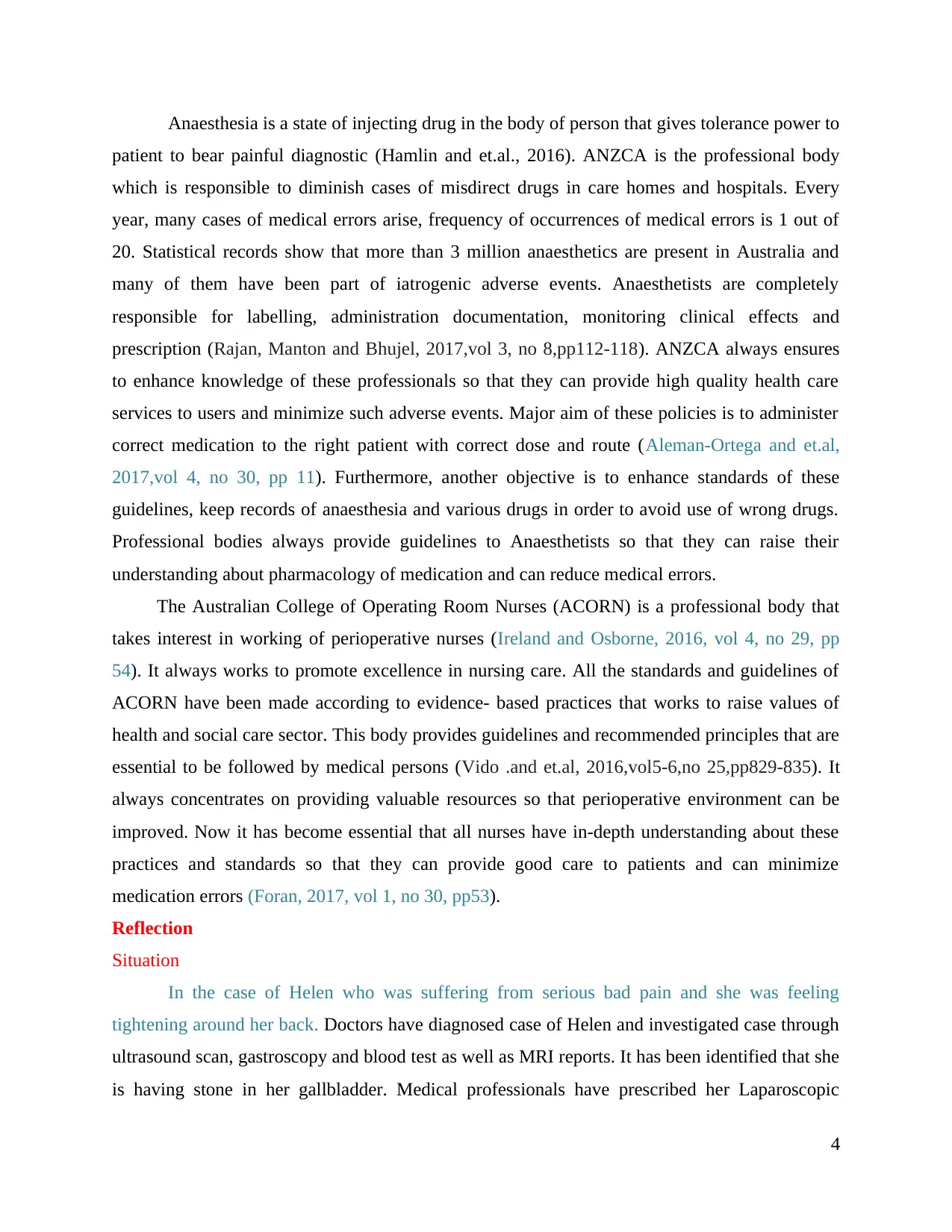
Anaesthesia is a state of injecting drug in the body of person that gives tolerance power to
patient to bear painful diagnostic (Hamlin and et.al., 2016). ANZCA is the professional body
which is responsible to diminish cases of misdirect drugs in care homes and hospitals. Every
year, many cases of medical errors arise, frequency of occurrences of medical errors is 1 out of
20. Statistical records show that more than 3 million anaesthetics are present in Australia and
many of them have been part of iatrogenic adverse events. Anaesthetists are completely
responsible for labelling, administration documentation, monitoring clinical effects and
prescription (Rajan, Manton and Bhujel, 2017,vol 3, no 8,pp112-118). ANZCA always ensures
to enhance knowledge of these professionals so that they can provide high quality health care
services to users and minimize such adverse events. Major aim of these policies is to administer
correct medication to the right patient with correct dose and route (Aleman-Ortega and et.al,
2017,vol 4, no 30, pp 11). Furthermore, another objective is to enhance standards of these
guidelines, keep records of anaesthesia and various drugs in order to avoid use of wrong drugs.
Professional bodies always provide guidelines to Anaesthetists so that they can raise their
understanding about pharmacology of medication and can reduce medical errors.
The Australian College of Operating Room Nurses (ACORN) is a professional body that
takes interest in working of perioperative nurses (Ireland and Osborne, 2016, vol 4, no 29, pp
54). It always works to promote excellence in nursing care. All the standards and guidelines of
ACORN have been made according to evidence- based practices that works to raise values of
health and social care sector. This body provides guidelines and recommended principles that are
essential to be followed by medical persons (Vido .and et.al, 2016,vol5-6,no 25,pp829-835). It
always concentrates on providing valuable resources so that perioperative environment can be
improved. Now it has become essential that all nurses have in-depth understanding about these
practices and standards so that they can provide good care to patients and can minimize
medication errors (Foran, 2017, vol 1, no 30, pp53).
Reflection
Situation
In the case of Helen who was suffering from serious bad pain and she was feeling
tightening around her back. Doctors have diagnosed case of Helen and investigated case through
ultrasound scan, gastroscopy and blood test as well as MRI reports. It has been identified that she
is having stone in her gallbladder. Medical professionals have prescribed her Laparoscopic
4
patient to bear painful diagnostic (Hamlin and et.al., 2016). ANZCA is the professional body
which is responsible to diminish cases of misdirect drugs in care homes and hospitals. Every
year, many cases of medical errors arise, frequency of occurrences of medical errors is 1 out of
20. Statistical records show that more than 3 million anaesthetics are present in Australia and
many of them have been part of iatrogenic adverse events. Anaesthetists are completely
responsible for labelling, administration documentation, monitoring clinical effects and
prescription (Rajan, Manton and Bhujel, 2017,vol 3, no 8,pp112-118). ANZCA always ensures
to enhance knowledge of these professionals so that they can provide high quality health care
services to users and minimize such adverse events. Major aim of these policies is to administer
correct medication to the right patient with correct dose and route (Aleman-Ortega and et.al,
2017,vol 4, no 30, pp 11). Furthermore, another objective is to enhance standards of these
guidelines, keep records of anaesthesia and various drugs in order to avoid use of wrong drugs.
Professional bodies always provide guidelines to Anaesthetists so that they can raise their
understanding about pharmacology of medication and can reduce medical errors.
The Australian College of Operating Room Nurses (ACORN) is a professional body that
takes interest in working of perioperative nurses (Ireland and Osborne, 2016, vol 4, no 29, pp
54). It always works to promote excellence in nursing care. All the standards and guidelines of
ACORN have been made according to evidence- based practices that works to raise values of
health and social care sector. This body provides guidelines and recommended principles that are
essential to be followed by medical persons (Vido .and et.al, 2016,vol5-6,no 25,pp829-835). It
always concentrates on providing valuable resources so that perioperative environment can be
improved. Now it has become essential that all nurses have in-depth understanding about these
practices and standards so that they can provide good care to patients and can minimize
medication errors (Foran, 2017, vol 1, no 30, pp53).
Reflection
Situation
In the case of Helen who was suffering from serious bad pain and she was feeling
tightening around her back. Doctors have diagnosed case of Helen and investigated case through
ultrasound scan, gastroscopy and blood test as well as MRI reports. It has been identified that she
is having stone in her gallbladder. Medical professionals have prescribed her Laparoscopic
4

Cholecystectomy (Street and et.al, 2018). Laparoscopic Cholecystectomy is the process of
removing gallbladder stone through surgical process. Before this operation patient is asked to go
through from pre operative assessment clinic (Australian and New Zealand College of
Anaesthetists (ANZZCA), 2018). In this pre-operative period in which doctors examines current,
past history of person and decides what kind of treatment would be more suitable for the patient.
Current state, past medical history, family background, etc.; all details are asked. All these things
affect Anaesthetic process to a great extent (Ooi and Thomson, 2015,vol 5, no 3, pp 393).
Action and outcome
After that, medical professionals have taken her blood for cross matching and requested for
electro cardio gram because Helen was in the age of 60 years. It is essential to examine all details
of the user carefully (Cook, 2017, vol 4, no119. pp.840-841.). If the person is taking alcohol then
due to injection of this drug individual may face dysfunction in liver (Clinical risk management
in anesthesia, 2018). Sometimes users feel stress that increases their blood pressure. At that time
if medical professionals give them Anaesthesia then it might negatively impact their health. Pre
operative process makes individual aware with process which is going to be applied for their
treatment. In the case of Helen, she was having no medical and family history and was not taking
any kind of medications recently. She had never gone with Anaesthetic process earlier to this
illness (Aleman-Ortega and et.al, 2017,vol 4, no 30, pp 11).
At the day when final operation was going to be occurred, nursing staffs has checked
current state of Helen and have ensured whether patient is fit or not for surgery. At that time her
blood pressure was found 120/90, temperature was 36.5, pluse rate was 70, blood pressure was
8.2 ((Ireland and Osborne, 2016, vol 4, no 29, pp 54). Helen was given 200mg drug during
surgery in order to tolerate pain during operation. This is case which clearly describes that
nursing staffs are required to cross check all medical issues of person and their family or past
histories. This can help them in giving correct dose of Anaesthesia with right route. Otherwise,
small ignorance can create complication for individual. It is essential for doctors to follow
Anaesthetic policies in their practices so that they can ensure safety of users. Surgical checklist
need to be prepared before anaesthetic induction (Davies and Shaw, 2014,vol 4, no 27,pp 42).
They have to cross check availability of all equipment and their maintenance. Each drug is used
for different purposes and these are applied to different patients as per their medical state. It is
5
removing gallbladder stone through surgical process. Before this operation patient is asked to go
through from pre operative assessment clinic (Australian and New Zealand College of
Anaesthetists (ANZZCA), 2018). In this pre-operative period in which doctors examines current,
past history of person and decides what kind of treatment would be more suitable for the patient.
Current state, past medical history, family background, etc.; all details are asked. All these things
affect Anaesthetic process to a great extent (Ooi and Thomson, 2015,vol 5, no 3, pp 393).
Action and outcome
After that, medical professionals have taken her blood for cross matching and requested for
electro cardio gram because Helen was in the age of 60 years. It is essential to examine all details
of the user carefully (Cook, 2017, vol 4, no119. pp.840-841.). If the person is taking alcohol then
due to injection of this drug individual may face dysfunction in liver (Clinical risk management
in anesthesia, 2018). Sometimes users feel stress that increases their blood pressure. At that time
if medical professionals give them Anaesthesia then it might negatively impact their health. Pre
operative process makes individual aware with process which is going to be applied for their
treatment. In the case of Helen, she was having no medical and family history and was not taking
any kind of medications recently. She had never gone with Anaesthetic process earlier to this
illness (Aleman-Ortega and et.al, 2017,vol 4, no 30, pp 11).
At the day when final operation was going to be occurred, nursing staffs has checked
current state of Helen and have ensured whether patient is fit or not for surgery. At that time her
blood pressure was found 120/90, temperature was 36.5, pluse rate was 70, blood pressure was
8.2 ((Ireland and Osborne, 2016, vol 4, no 29, pp 54). Helen was given 200mg drug during
surgery in order to tolerate pain during operation. This is case which clearly describes that
nursing staffs are required to cross check all medical issues of person and their family or past
histories. This can help them in giving correct dose of Anaesthesia with right route. Otherwise,
small ignorance can create complication for individual. It is essential for doctors to follow
Anaesthetic policies in their practices so that they can ensure safety of users. Surgical checklist
need to be prepared before anaesthetic induction (Davies and Shaw, 2014,vol 4, no 27,pp 42).
They have to cross check availability of all equipment and their maintenance. Each drug is used
for different purposes and these are applied to different patients as per their medical state. It is
5
Paraphrase This Document
Need a fresh take? Get an instant paraphrase of this document with our AI Paraphraser
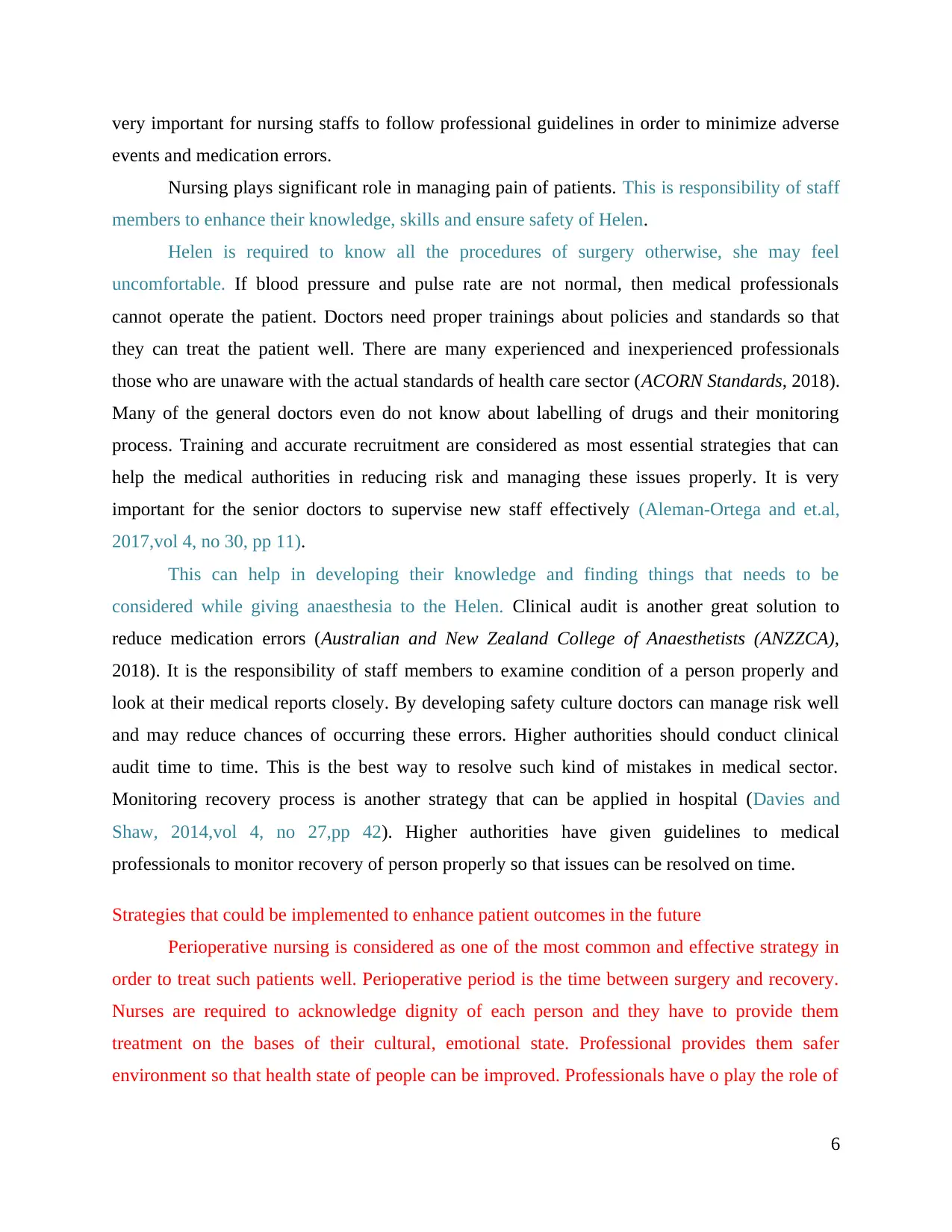
very important for nursing staffs to follow professional guidelines in order to minimize adverse
events and medication errors.
Nursing plays significant role in managing pain of patients. This is responsibility of staff
members to enhance their knowledge, skills and ensure safety of Helen.
Helen is required to know all the procedures of surgery otherwise, she may feel
uncomfortable. If blood pressure and pulse rate are not normal, then medical professionals
cannot operate the patient. Doctors need proper trainings about policies and standards so that
they can treat the patient well. There are many experienced and inexperienced professionals
those who are unaware with the actual standards of health care sector (ACORN Standards, 2018).
Many of the general doctors even do not know about labelling of drugs and their monitoring
process. Training and accurate recruitment are considered as most essential strategies that can
help the medical authorities in reducing risk and managing these issues properly. It is very
important for the senior doctors to supervise new staff effectively (Aleman-Ortega and et.al,
2017,vol 4, no 30, pp 11).
This can help in developing their knowledge and finding things that needs to be
considered while giving anaesthesia to the Helen. Clinical audit is another great solution to
reduce medication errors (Australian and New Zealand College of Anaesthetists (ANZZCA),
2018). It is the responsibility of staff members to examine condition of a person properly and
look at their medical reports closely. By developing safety culture doctors can manage risk well
and may reduce chances of occurring these errors. Higher authorities should conduct clinical
audit time to time. This is the best way to resolve such kind of mistakes in medical sector.
Monitoring recovery process is another strategy that can be applied in hospital (Davies and
Shaw, 2014,vol 4, no 27,pp 42). Higher authorities have given guidelines to medical
professionals to monitor recovery of person properly so that issues can be resolved on time.
Strategies that could be implemented to enhance patient outcomes in the future
Perioperative nursing is considered as one of the most common and effective strategy in
order to treat such patients well. Perioperative period is the time between surgery and recovery.
Nurses are required to acknowledge dignity of each person and they have to provide them
treatment on the bases of their cultural, emotional state. Professional provides them safer
environment so that health state of people can be improved. Professionals have o play the role of
6
events and medication errors.
Nursing plays significant role in managing pain of patients. This is responsibility of staff
members to enhance their knowledge, skills and ensure safety of Helen.
Helen is required to know all the procedures of surgery otherwise, she may feel
uncomfortable. If blood pressure and pulse rate are not normal, then medical professionals
cannot operate the patient. Doctors need proper trainings about policies and standards so that
they can treat the patient well. There are many experienced and inexperienced professionals
those who are unaware with the actual standards of health care sector (ACORN Standards, 2018).
Many of the general doctors even do not know about labelling of drugs and their monitoring
process. Training and accurate recruitment are considered as most essential strategies that can
help the medical authorities in reducing risk and managing these issues properly. It is very
important for the senior doctors to supervise new staff effectively (Aleman-Ortega and et.al,
2017,vol 4, no 30, pp 11).
This can help in developing their knowledge and finding things that needs to be
considered while giving anaesthesia to the Helen. Clinical audit is another great solution to
reduce medication errors (Australian and New Zealand College of Anaesthetists (ANZZCA),
2018). It is the responsibility of staff members to examine condition of a person properly and
look at their medical reports closely. By developing safety culture doctors can manage risk well
and may reduce chances of occurring these errors. Higher authorities should conduct clinical
audit time to time. This is the best way to resolve such kind of mistakes in medical sector.
Monitoring recovery process is another strategy that can be applied in hospital (Davies and
Shaw, 2014,vol 4, no 27,pp 42). Higher authorities have given guidelines to medical
professionals to monitor recovery of person properly so that issues can be resolved on time.
Strategies that could be implemented to enhance patient outcomes in the future
Perioperative nursing is considered as one of the most common and effective strategy in
order to treat such patients well. Perioperative period is the time between surgery and recovery.
Nurses are required to acknowledge dignity of each person and they have to provide them
treatment on the bases of their cultural, emotional state. Professional provides them safer
environment so that health state of people can be improved. Professionals have o play the role of
6

advocate for the patients. Nurses have to ensure that they create such atmosphere for them so that
physical and emotional needs of patients can be met (Ooi and Thomson, 2015).
Patient’s safety is the most important part of health and social care sector thus; it is
essential to manage all accountable items properly (Weller, Sullivan and Boland, 2017). Another
guideline is for clinical practice which describes that nurses are required to use aseptic
techniques and infection prevention procedure in order to protect life of patients. Authorities are
required to create healthy perioperative environment so that visitors do not feel uncomfortable
(Davies and Shaw, 2014,vol 4, no 27,pp 42). Training modules have been designed by the
MATT and it is approved by ACORN. The main agenda of designing these training modules is
to develop understanding of nurses and make them aware with practical overview. Thus, nurses
are required to implement this knowledge to their workplace environment and have to provide
them satisfactory treatment (Rajan, Manton and Bhujel, 2017).
In the present case, Helen was suffering from bed abdominal pain and she was unable to
communicate well with patients. In such condition nurses were unable to understand critical
needs of her. Professionals are required to take care of dignity of Helen so that she can feel
comfortable and can communicate with nurses properly. This can support in understanding
medical needs and actual cause of illness. Proper communication and providing safer
environment aid in improving wellbeing of patients to great extent.
CONCLUSION
From the above study, it can be concluded that anaesthesia is given to users to make them
unconscious. This is used to increase their tolerance capacity to bear pain of surgery. Doctors are
required to monitor condition of patients timely and they have to find root cause of their
problems. Root cause analysis and proper monitoring are effective strategies that can support
medical professionals in minimizing medication errors and nursing staff can provide high quality
care services to patients.
7
physical and emotional needs of patients can be met (Ooi and Thomson, 2015).
Patient’s safety is the most important part of health and social care sector thus; it is
essential to manage all accountable items properly (Weller, Sullivan and Boland, 2017). Another
guideline is for clinical practice which describes that nurses are required to use aseptic
techniques and infection prevention procedure in order to protect life of patients. Authorities are
required to create healthy perioperative environment so that visitors do not feel uncomfortable
(Davies and Shaw, 2014,vol 4, no 27,pp 42). Training modules have been designed by the
MATT and it is approved by ACORN. The main agenda of designing these training modules is
to develop understanding of nurses and make them aware with practical overview. Thus, nurses
are required to implement this knowledge to their workplace environment and have to provide
them satisfactory treatment (Rajan, Manton and Bhujel, 2017).
In the present case, Helen was suffering from bed abdominal pain and she was unable to
communicate well with patients. In such condition nurses were unable to understand critical
needs of her. Professionals are required to take care of dignity of Helen so that she can feel
comfortable and can communicate with nurses properly. This can support in understanding
medical needs and actual cause of illness. Proper communication and providing safer
environment aid in improving wellbeing of patients to great extent.
CONCLUSION
From the above study, it can be concluded that anaesthesia is given to users to make them
unconscious. This is used to increase their tolerance capacity to bear pain of surgery. Doctors are
required to monitor condition of patients timely and they have to find root cause of their
problems. Root cause analysis and proper monitoring are effective strategies that can support
medical professionals in minimizing medication errors and nursing staff can provide high quality
care services to patients.
7

REFERENCES
Books and Journals
Aleman-Ortega, H. and et.al., 2017. Neuraxial anaesthesia and the use of sterile gowning.
ACORN: The Journal of Perioperative Nursing in Australia. 30(4). pp.11.
Althiabat, T., 2017. institute of health sciences (doctoral dissertation, near east university).
Cook, T. M., 2017. Response to: Emergency front-of-neck access: scalpel or cannula—and the
parable of Buridan’s ass. BJA: British Journal of Anaesthesia. 119(4). pp.840-841.
Davies, M. and Shaw, E., 2014. Safer Australian surgical teamwork-a multidisciplinary human
factors project. ACORN: The Journal of Perioperative Nursing in Australia. 27(4). pp.42.
Foran, P., 2017. ACORN education at EORNA. ACORN: The Journal of Perioperative Nursing
in Australia. 30(3). pp.51.
Foran, P., 2017. Education report. ACORN: The Journal of Perioperative Nursing in Australia.
30(1). pp.53.
Hamlin, L. and et.al., 2016. Perioperative Nursing-EBook-epub: An Introduction. Elsevier
Health Sciences.
Ireland, S. and Osborne, S., 2016. Reviewing ACORN nursing role'Anaesthetic nurse'. ACORN:
The Journal of Perioperative Nursing in Australia. 29(4). pp.54.
Ooi, M. and Thomson, A., 2015. Morbidity and mortality of endoscopist-directed nurse-
administered propofol sedation (EDNAPS) in a tertiary referral center. Endoscopy
international open. 3(5). pp.E393.
Rajan, S., Manton, D. J. and Bhujel, N., 2017. A review of contemporary inhalation sedation
guidelines and regulations related to treating children. Faculty Dental Journal. 8(3).
pp.112-118.
Street, M. and et.al., 2018. Refining nursing assessment and management with a new
postanaesthetic care discharge tool to minimize surgical patient risk. Journal of Advanced
Nursing.
Vidot, H.and et.al., 2016. A prospective audit of preprocedural fasting practices on a transplant
ward: when fasting becomes starving. Journal of clinical nursing. 25(5-6). pp.829-835.
Weller, J. M., Sullivan, M. and Boland, J., 2017. Does variable training lead to variable care?
Online
8
Books and Journals
Aleman-Ortega, H. and et.al., 2017. Neuraxial anaesthesia and the use of sterile gowning.
ACORN: The Journal of Perioperative Nursing in Australia. 30(4). pp.11.
Althiabat, T., 2017. institute of health sciences (doctoral dissertation, near east university).
Cook, T. M., 2017. Response to: Emergency front-of-neck access: scalpel or cannula—and the
parable of Buridan’s ass. BJA: British Journal of Anaesthesia. 119(4). pp.840-841.
Davies, M. and Shaw, E., 2014. Safer Australian surgical teamwork-a multidisciplinary human
factors project. ACORN: The Journal of Perioperative Nursing in Australia. 27(4). pp.42.
Foran, P., 2017. ACORN education at EORNA. ACORN: The Journal of Perioperative Nursing
in Australia. 30(3). pp.51.
Foran, P., 2017. Education report. ACORN: The Journal of Perioperative Nursing in Australia.
30(1). pp.53.
Hamlin, L. and et.al., 2016. Perioperative Nursing-EBook-epub: An Introduction. Elsevier
Health Sciences.
Ireland, S. and Osborne, S., 2016. Reviewing ACORN nursing role'Anaesthetic nurse'. ACORN:
The Journal of Perioperative Nursing in Australia. 29(4). pp.54.
Ooi, M. and Thomson, A., 2015. Morbidity and mortality of endoscopist-directed nurse-
administered propofol sedation (EDNAPS) in a tertiary referral center. Endoscopy
international open. 3(5). pp.E393.
Rajan, S., Manton, D. J. and Bhujel, N., 2017. A review of contemporary inhalation sedation
guidelines and regulations related to treating children. Faculty Dental Journal. 8(3).
pp.112-118.
Street, M. and et.al., 2018. Refining nursing assessment and management with a new
postanaesthetic care discharge tool to minimize surgical patient risk. Journal of Advanced
Nursing.
Vidot, H.and et.al., 2016. A prospective audit of preprocedural fasting practices on a transplant
ward: when fasting becomes starving. Journal of clinical nursing. 25(5-6). pp.829-835.
Weller, J. M., Sullivan, M. and Boland, J., 2017. Does variable training lead to variable care?
Online
8
Secure Best Marks with AI Grader
Need help grading? Try our AI Grader for instant feedback on your assignments.
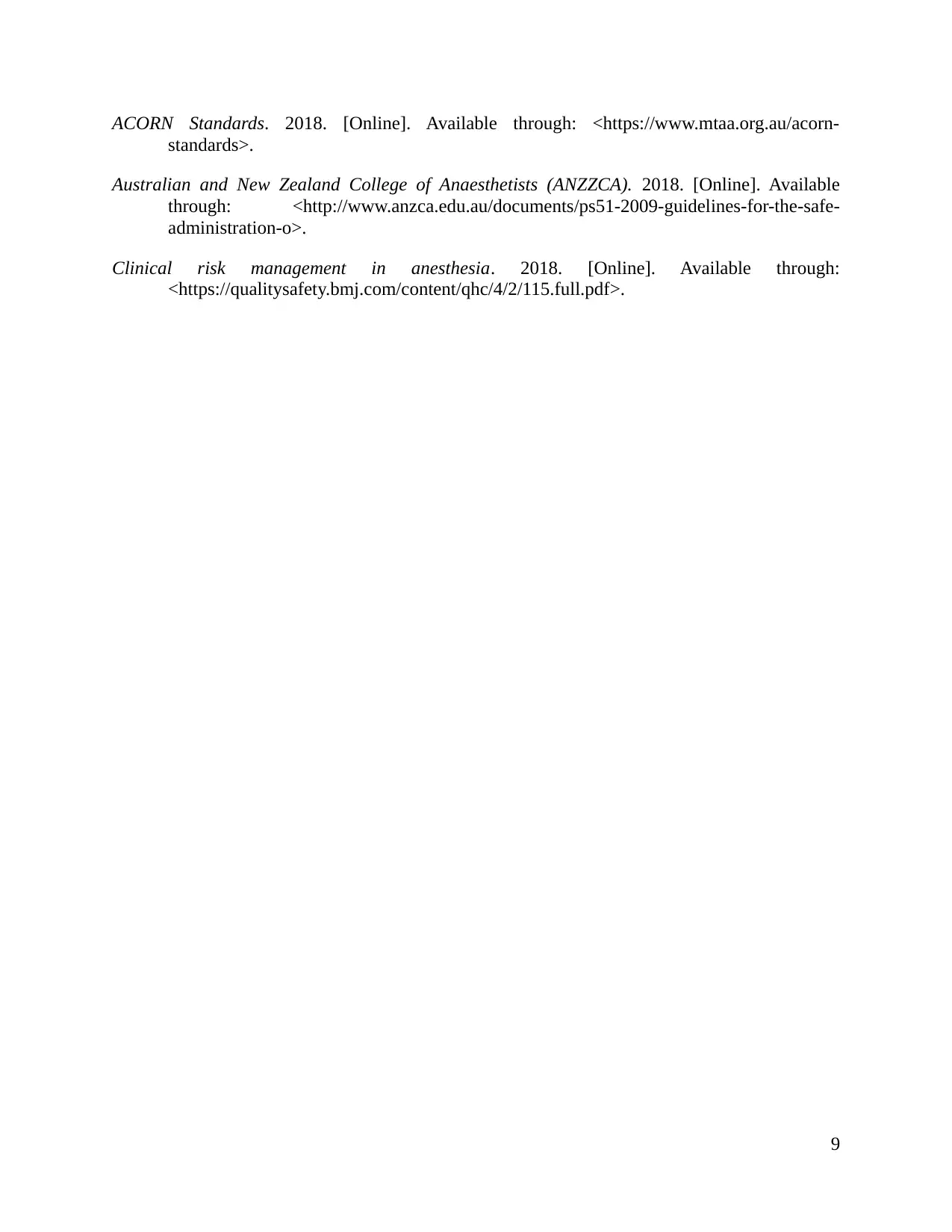
ACORN Standards. 2018. [Online]. Available through: <https://www.mtaa.org.au/acorn-
standards>.
Australian and New Zealand College of Anaesthetists (ANZZCA). 2018. [Online]. Available
through: <http://www.anzca.edu.au/documents/ps51-2009-guidelines-for-the-safe-
administration-o>.
Clinical risk management in anesthesia. 2018. [Online]. Available through:
<https://qualitysafety.bmj.com/content/qhc/4/2/115.full.pdf>.
9
standards>.
Australian and New Zealand College of Anaesthetists (ANZZCA). 2018. [Online]. Available
through: <http://www.anzca.edu.au/documents/ps51-2009-guidelines-for-the-safe-
administration-o>.
Clinical risk management in anesthesia. 2018. [Online]. Available through:
<https://qualitysafety.bmj.com/content/qhc/4/2/115.full.pdf>.
9
1 out of 11
Your All-in-One AI-Powered Toolkit for Academic Success.
+13062052269
info@desklib.com
Available 24*7 on WhatsApp / Email
![[object Object]](/_next/static/media/star-bottom.7253800d.svg)
Unlock your academic potential
© 2024 | Zucol Services PVT LTD | All rights reserved.





